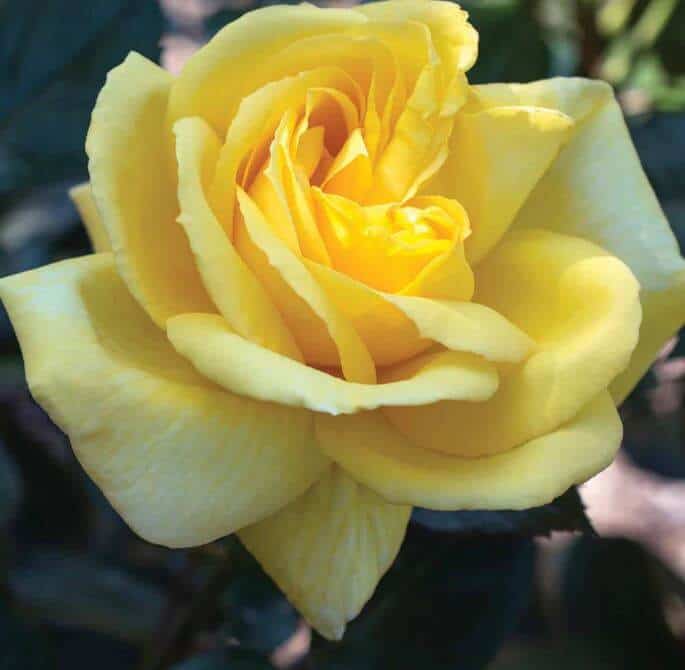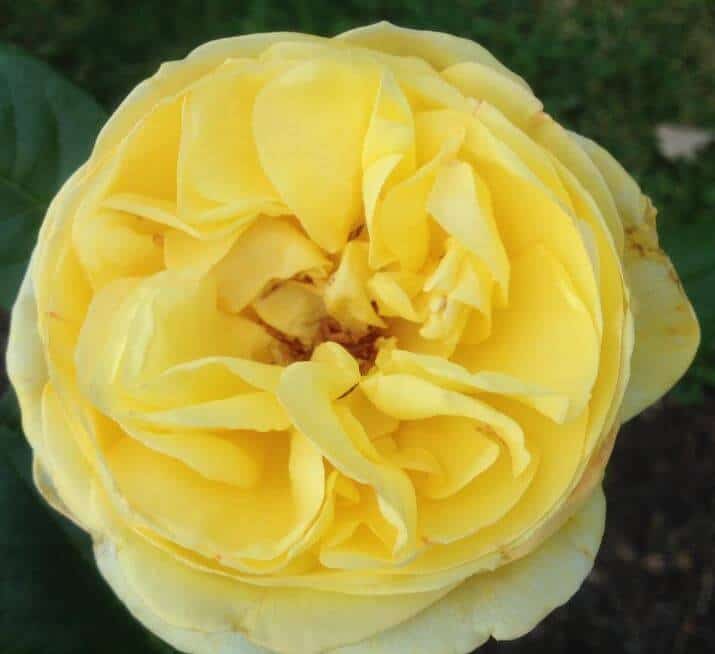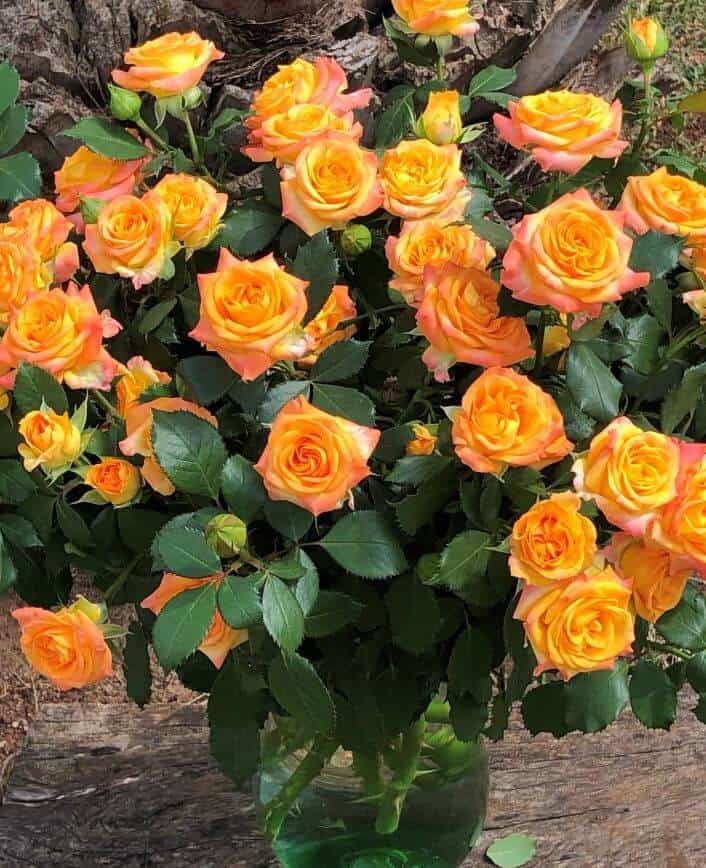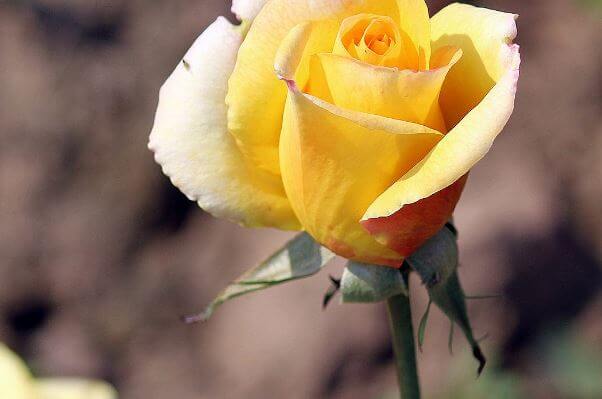Last Updated on January 7, 2023 by a Friendly Gardener
Roses are a garden favorite, offering a palette of beautiful colors and delicate fragrances to choose from and enjoy. Many roses come in a shrub form making them invaluable for home garden landscaping. Planted as walkway borders, in rose gardens, climbing up pergolas, or snipping freshly cut roses for home décor are among the benefits that rose cultivation provides. For rose enthusiasts, the hybrid tea rose is most certainly a popular choice.
History of the Tea Rose

The Eternal Flame rose is classified as a hybrid tea rose, an informal horticultural classification. The hybrid tea roses were born in France in the mid-1800s. These roses are hybrids because they were created thanks to the crossbreeding of the Tea rose and Hybrid Perpetuals. This particular group of roses is the oldest classification recognized among modern garden roses.
Frenchman Jean-Baptiste André Guillot presented the rose “La France” as early as 1867, which some consider the very first hybrid tea rose. Other historians suggest that tea roses may have been developed as much as a decade earlier again in France.
British rose breeder, Henry Bennett, presented ten tea rose pedigree hybrids in 1879. He had attempted to breed roses as early as 1868 but failed. From 19870 to 1872, Bennett visited breeders in France. Upon his return home, he increased his attempts at rose breeding on his farm even building heated greenhouses.
Hybrid tea roses began to enjoy increased popularity at the start of the 20th century with the introduction of the Soleil d’Or by French breeder Joseph Pernet-Ducher in 1900.
The Eternal Flame Hybrid Tea Rose is attributed to breeder Alain Meilland in France in 2007.
All About the Eternal Flame Rose

The Eternal Flame rose is a hybrid tea rose featuring high-centered flowers classically shaped in soft-hued yellow. The bush grows tall with an erect posture. Stems are long and this rose offers a citrusy fragrance resembling a mix of lemon and orange making it an ideal choice for gardeners who intend to cut their roses for indoor use.
The eternal flame blooms repeatedly over a long season beginning in late spring and ending in late fall. Blooms will generally appear singly with a flower unfurling at the end of each stem. Winter hardiness is above average, as is this plant’s resistance to disease. They generally have a lifespan of six to ten years.
The Eternal Flame Rose is a rapid grower and should reach its mature size in three to four years based on environmental conditions. They can grow to heights from three to eight feet. These roses can be planted year-round although early spring and late autumn are ideal because they are dormant. When planting more than one bush outdoors, space them approximately three feet apart. These members of the Rosaceae family, as cultivars, have no specific native habitat.
Eternal Flame Rose Care

Care for a hybrid tea rose is similar to regular rose care. They thrive in generous sunlight and acidic soil with good humidity and feeding.
Soil
The Eternal Flame Rose will do well in clay, chalk, sandy, or loamy soil beds. When planting the Eternal Flame Rose, prepare a hole with a mound of dirt inside it. Spread roots over the mound and then fill the hole with the soil that has been amended with organic matter.
These roses like acidic soil that has a pH of 6 to 6.5. Mulching will permit your rose to maintain its roots cool and conserve water. In the spring, after you have removed any winter protection, apply a 4-inch layer of mulch. If you reside in a warm climate, apply the mulch with the swelling of leaf buds.
Light
Your Eterna Flame will flower best if it has access to full sunlight, but it can manage with a little shade. Sun exposure increases flowering and aids the plant with disease resistance.
Water
Supply your Eternal Flame Rose with an inch or two of water weekly. This can vary if climate conditions are more extreme. Hot climates as well as sandy soil beds will require more watering. Check the topsoil. When it feels dry to approximately three inches deep, watering is needed. Avoid wetting foliage when watering to prevent diseases, but water deeply at the plant base to stimulate the growth of the plant’s root system. If roots grow deeply enough, they will have greater tolerance in the event of a period of drought.
Humidity
The Eternal Flame Rose will bloom best in a humid environment. If you live in a zone that has very high humidity, however, mildew tea rose varieties are best. In arid climates, heat-resistant varieties of tea roses are recommended.
Temperature
80.6°F is the ideal temperature for this hybrid tea rose.
Feeding

Fertilizing regularly will make for a happy plant. Hybrid tea roses are notoriously heavy feeders. At the very beginning of spring, when removing winter protection, apply a rose fertilizer (1-0,8-1.8 NPK) for the first time.
Continue to feed your rose plant weekly or bi-weekly depending on the type and strength of fertilizer used. End feeding approximately a month to six weeks before your area’s first projected frost date.
Iron is very important in the event of high soil pH. If foliage turns yellow with green veining, you will need to add an iron supplement to your feeding. If soil magnesium is low, apply a third of a cup of Epsom salts twice annually with generous watering.
Pruning
The pruning of hybrid tea roses resembles that of other roses. Damaged, diseased, or dead stems should be trimmed as well as thin stems that measure less than a ½-inch in diameter. If you regularly snip flowers, you will have less pruning to do. If you need to prune, do so at the beginning of spring to stimulate new growth. Stems should be pruned a third of their length. Regular pruning will encourage stem strength and larger blooms.
When trimming your roses, cut at a 45° angle approximately one-quarter-inch above a bud that faces outward. Always leave several leaves on a stem.
Overwintering
If you live in an area with a harsh winter climate, use added protection for your Eternal Flame Rose. Consistent soil moisture and pruning will help your plant weather the winter. Stems can be sprayed with sulfur for better protection.
Eternal Flame Rose Problems
This hybrid tea rose offers good disease resistance. Nonetheless, they are susceptible to a few problems including
- Black spot disease
- Botrytis blight
- Crown gall
- Fungus such as powdery mildew
Roses are also at risk for spider mites and Japanese Beetle infestations.
- Curling Foliage
This generally indicates a viral infection. There is no cure other than destroying the affected roses.
- Yellowing Foliage
Yellowing leaves can be an indication of Black Spot disease.
- Leaf Drop
Black Spot Disease can also cause leaves to fall off, or leaf drops may be caused by a fungal infection.
Eternal Rose Propagation

Budding is the most successful method for hybrid tea rose propagation. Follow these steps to propagate your rose plant.
- Prepare a peat pot with water and vermiculite and prepare a hole 2-inches deep
- Trim a stem cutting just below the fourth set of leaves. Cut at a 45° angle
- Place the cutting into the hole
- Position sticks or twigs approximately 8-inches in height around the peat pot perimeter
- Now position the peat pot in a container, cup, or pot with drainage holes
- Cover the entire container with a plastic bag but do not allow the plastic to touch the cutting’s leaves
- Place in a shaded location
- Check your cutting daily and expect growth in a month to six weeks.
Indoor Cultivation
Any rose variety can be cultivated indoors if the outdoor environmental conditions are recreated.

